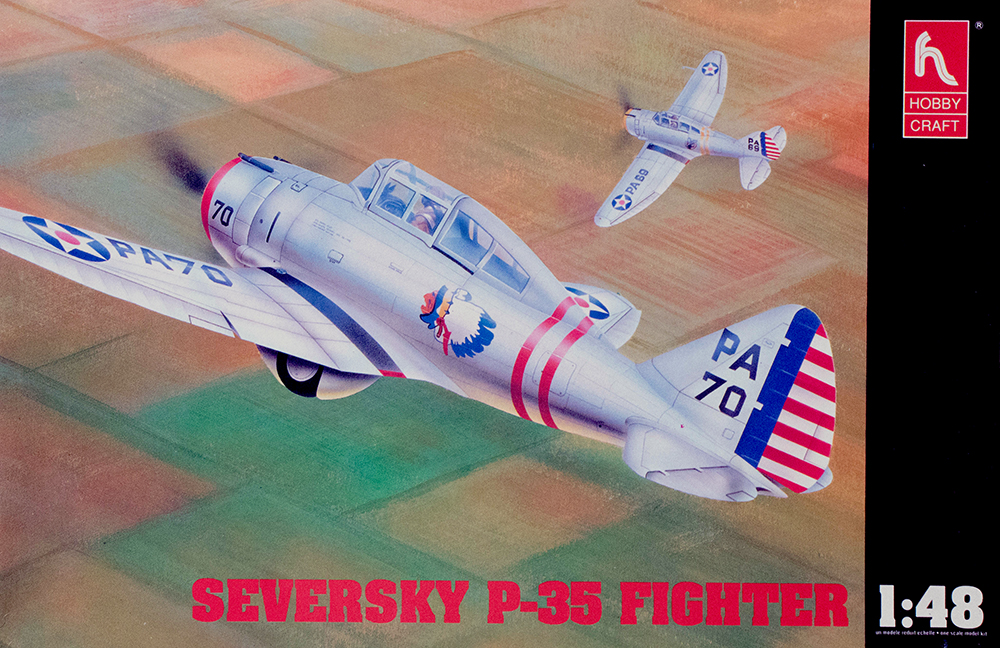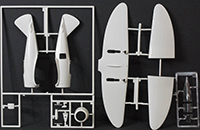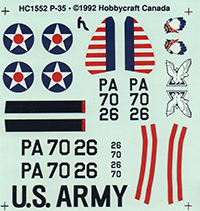
Hobbycraft 1/48 Seversky P-35 Kit First Look
By Michael Benolkin
| Date of Review | August 2017 | Manufacturer | Hobbycraft |
|---|---|---|---|
| Subject | Seversky P-35 | Scale | 1/48 |
| Kit Number | 1552 | Primary Media | Styrene |
| Pros | Nice kit | Cons | See text |
| Skill Level | Basic | MSRP (USD) | OOP |
First Look
 |
 |
 |
Alexander de Seversky, a Russian immigrant to the US, formed Seversky Aviation Corporation in 1931 and one of his early projects was the SEV-3 amphibian which later shed its floats for landing gear to become the BT-8 trainer. When the US Army Air Corps issued a requirement for a single-seat fighter in 1935, Seversky submitted another outgrowth of the SEV to fly against the Curtiss Model 75. One of the problems of aircraft development in those days was that engines that were adopted for their specifications rarely performed up to those specifications and many of Seversky's designs were deemed underpowered. When the USAAC delayed the fly-off, Seversky's team changed engines to the Pratt & Whitney R1830 Twin Wasp. While that engine also failed to operate at specified horsepower, the Seversky prototype won the flyoff and production of the P-35 began.
The P-35 was the first single-seat fighter to feature retractable landing gear, all-metal airframe, and a fully enclosed cockpit together in one airframe. The P-35 also featured a 'wet wing', where the skin of the wing doubled as part of the fuel cell to save weight. As you might imagine, these early wet wing designs had serious problems with leaks. Seversky delivered 76 of the contracted 77 airframes to the USAAC in about two years from contract award, with the 77th airframe held over to develop the XP-41. When the USAAC wanted more single-seat fighters, they acquired the Curtiss P-36 Hawk due to the slow pace of Seversky's production line and their sales of aircraft to the Japanese Navy.
de Seversky continued to sell the P-35 to other nations while the USAAC had moved on to the P-43 Lancer. By 1940, de Seversky had been forced out of the company, which had been renamed Republic by the board of directors, and that company would go on to produce the rugged P-47 Thunderbolt during World War II. Despite being deemed obsolete shortly after its introduction into the USAAC, the P-35 would nonetheless serve through the first days of World War II though not a match against the Japanese A6M Zero. The Swedish Air Force purchased the P-35, designated as J-9, but only a portion were delivered before the US imposed an export embargo on aircraft not going to Britain in the months before it entered World War II. The aircraft that were supposed to go to Sweden after the embargo were stored at the Republic factory until requisitioned into USAAC service as the P-35A. Those aircraft that did reach Sweden would serve throughout World War II before being retired in 1952.
Here is the Hobbycraft Canada 1/48 P-35 tooling which later appeared in Academy boxings. I recall some turmoil as many kit toolings in the Hobbycraft line were taken over by Academy. This shift left some modelers believing that the Academy kits were new-tooled subjects rather than recycled Hobbycraft molds, but indeed they do come from the tooling used by Hobbycraft.
The kit is molded in gray styrene and presented on three parts trees plus on tree of clear parts. The tooling does feature finely scribed lines and no mold flash. Among the features and options in this kit:
- Spartan cockpit
- Basic Twin Wasp engine
- Positionable canopy
- Positionable landing gear
One difference between this kit and some of Academy's releases is that fuselage side panel. This kit represents the P-35 which may have had an access door on the right side, but the Academy kit provides the clear door instead to replicate the reconnaissance mods adopted by the Swedish AF.
Decals provide markings for:
- P-35, PA-26, 17 PS, USAAC, 1939
- P-35, PA-70, 94 PS, USAAC, 1938
While the kit is basic as far as cockpit and engine details are concerned, it provides a good foundation for the skilled modeler to add those missing details and create a masterpiece. To date, the only options for this subject in 1/48 scale is the Hobbycraft/Academy tooling and oddly enough, you only have that same option for Curtiss' P-36 Hawk in this scale. Many of the photos you see of this subject are bare metal examples from the mid-late 1930s, the surviving P-35 and P-36 airframes were camouflaged before moving to their forward positions in the days before the US entered the war.







